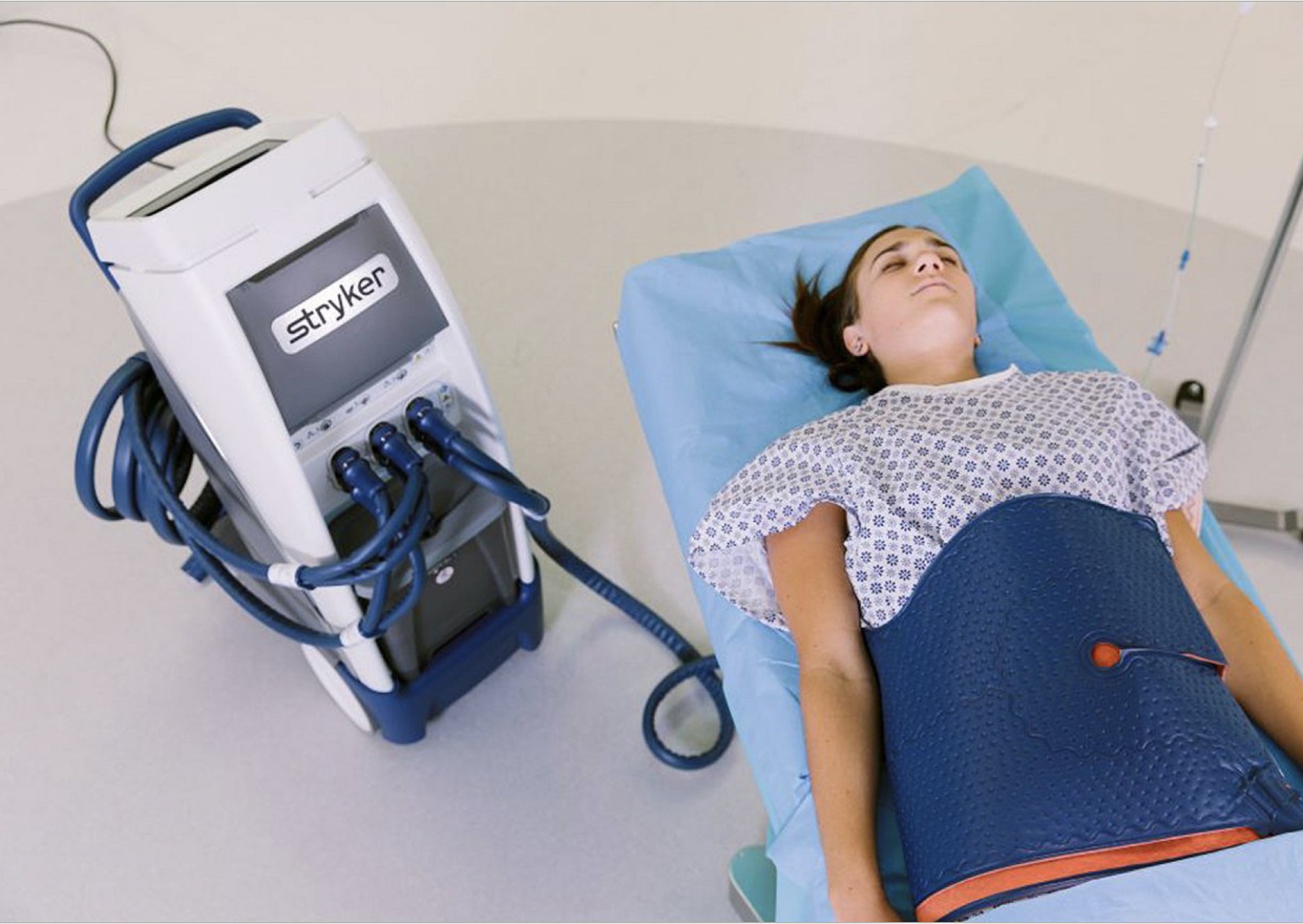
How might we…
make real-time and post therapy data more actionable for providers?
Stryker
Discovery Research, Process Mapping, Information Architecture, Systems Design, UX/UI Design
Overview
-
Stryker is a renowned medical device company known for its innovative and high-quality products that aim to improve patient outcomes and enhance healthcare delivery.
-
6 Months, August — January, 2021
-
My Role: Lead Designer
Matt Smith, Senior Designer
-
Miro, Figma
-
Screener Questionnaire and Research Guides
Personas
In-depth user Journey Maps and user flows
Service blueprint
Strategic UX roadmap and definition of MVP epics + features
UI design system
MVP of mobile-friendly web app and native app
Challenge
Problem
The current system restricts access to real-time and post-therapy patient data solely to the machine, necessitating constant monitoring by physicians or nurses for alerts or alarms, while also making it challenging to track outcomes and protocol adherence.
Solution
In collaboration with the Stryker team, we developed a mobile and desktop app that empowers physicians and nurses to:
Swiftly and confidently respond by providing access to real-time data
Enhance protocols and optimize TTM care outcomes through post-therapy data analysis
tldr;
The Altrix Machine (right) is used for Targeted Temperature Management (TTM) to regulate patient temperatures through the delivery of water at a specific temperature via a wrap-around channel, as seen above.
TTM is often employed in critical care settings, particularly in situations such as cardiac arrest, stroke, or traumatic brain injury. The process involves intentionally lowering or raising a person's body temperature to help protect vital organs, minimize damage, and improve patient outcomes.
In collaboration with Stryker, we helped create a more connected experience utilizing their Health Cloud platform, allowing nurses and physicians to monitor and manage patient activity beyond the device interface itself.
We designed a mobile app to reduce critical response time with real-time alerts and a desktop app to enable managers to review, filter, and compare post-therapy cases to improve clinical protocols.
Context
Hypothesis
By understanding how medical professionals currently interact with the device we could begin defining the boundaries of the ecosystem and explore how the data flows and is presented between the various mediums. By utilizing their in-house “Health Cloud” Stryker could enable health professionals to provide the best possible care quickly, and with confidence.
Challenges
Our biggest challenge surfaced as an information architecture problem stemming from 2 primary sources. A shortened timeline provided limited time/resources to adequately dive deep into the objects, relationships, and information available and also what’s desired by the people using the system. This was compounded by a lack of engagement from SMEs, which became clear as the project progressed.
Process
-
Frame and conduct research for Clinician interviews
Analyze all existing documentation and synthesize user interview insights
-
Create user flows, journey maps, and service blueprints to understand processes and identify opportunities
Leverage information architecture and object relationships to define MVP epics and features
-
Build a design system and UI library for the first version of the app
Design the MVP of mobile-friendly web app MVP (Interactive Prototype)
Design a Native App to deliver specific value features
-
Clean hand-off to Stryker engineers and development team
Understanding clinicians’ unique
needs of the Altrix application
Personas
Through a series of interviews, we derived personas that provided deeper comprehension of user roles, including the bedside nurse, physician, and nurse manager. By examining their primary responsibilities, pain points, needs, motivations, and typical behaviors, we gained valuable understanding to inform opportunities and requirements.
Jobs to be Done framework
Through meeting with medical professionals, we identified and broke down ‘jobs’ that need to be done, and identified opportunities for improvement.
Clinical Journey Mapping
I visualized TTM Therapy through the lens of the Nurse, Nurse Manager, and Physician. We focused on Pre-Therapy, Therapy, and Post Therapy Analysis to pinpoint specific customer journey touchpoints that cause friction or delight. By leading collaborative workshops to foster shared understanding, we surfaced unknowns and leveraged new insights to drive action.
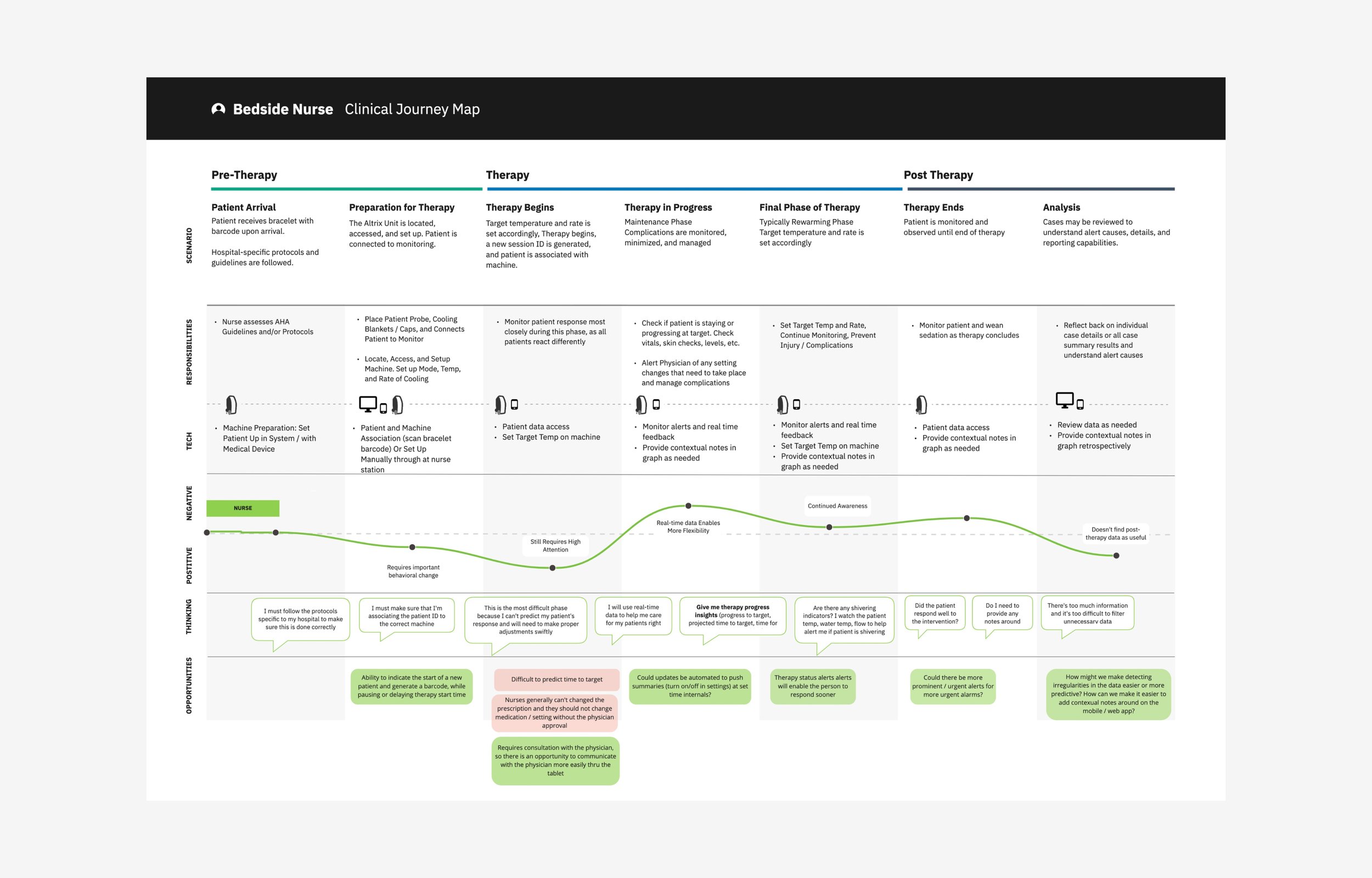
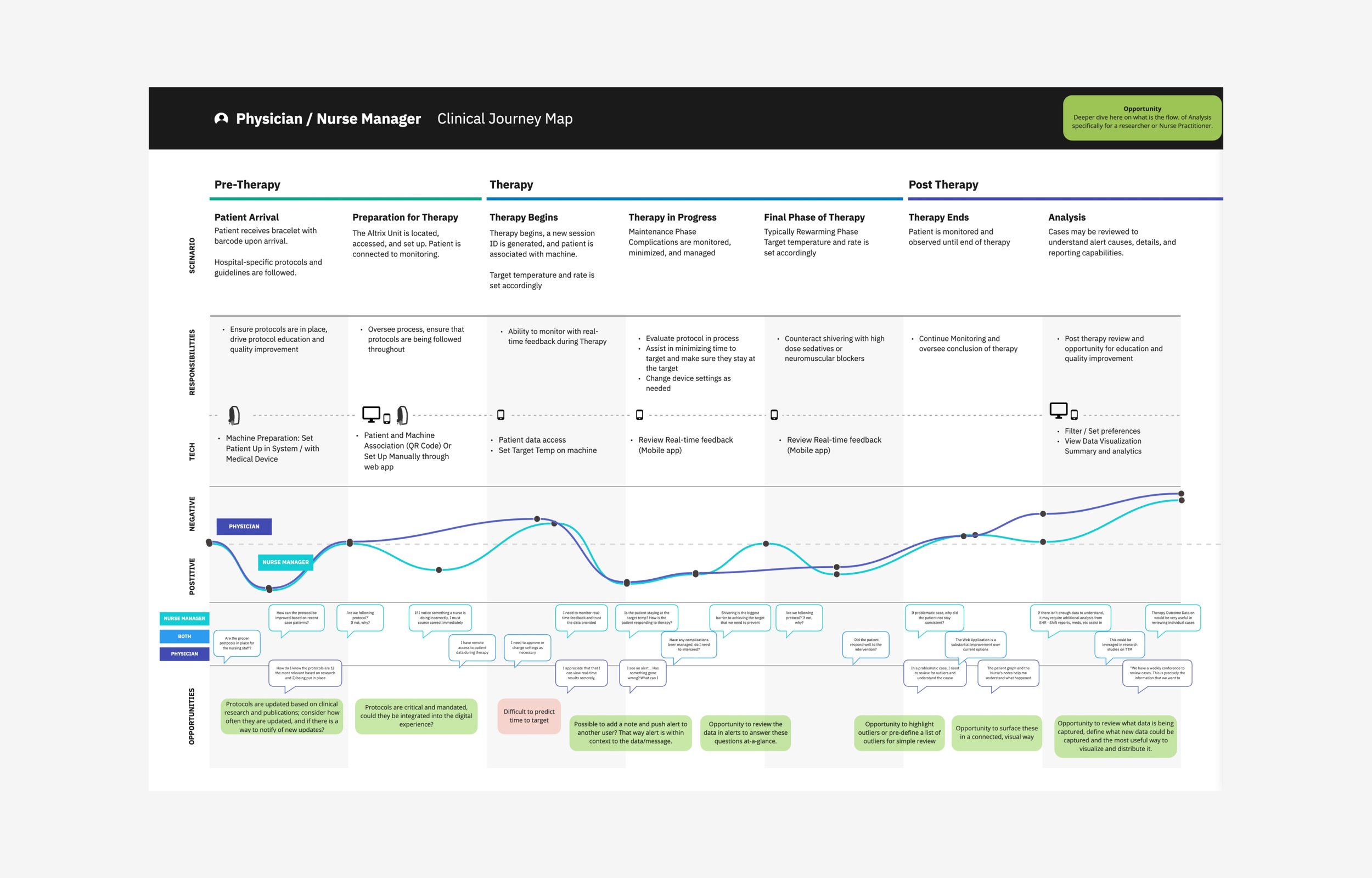
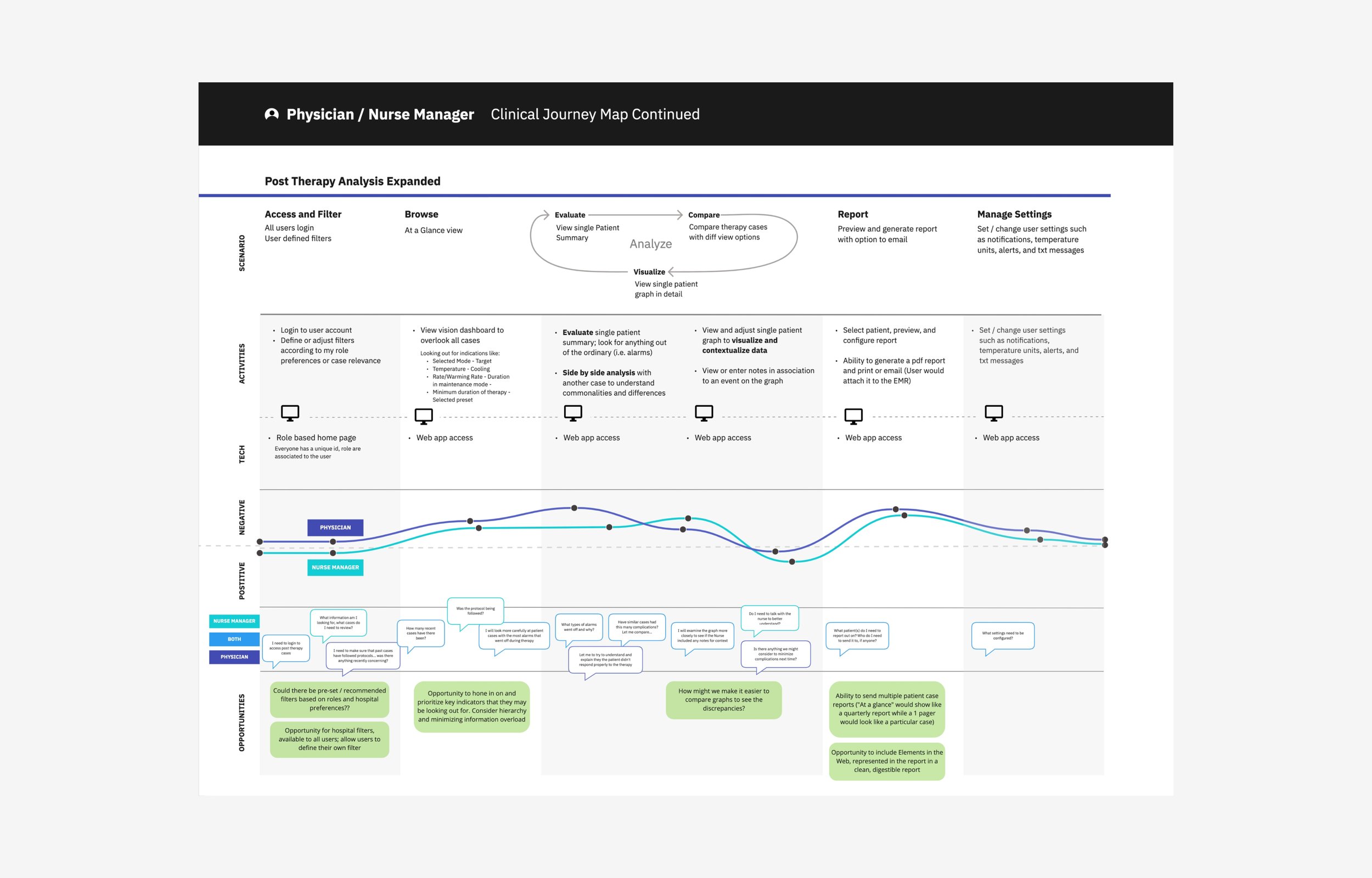
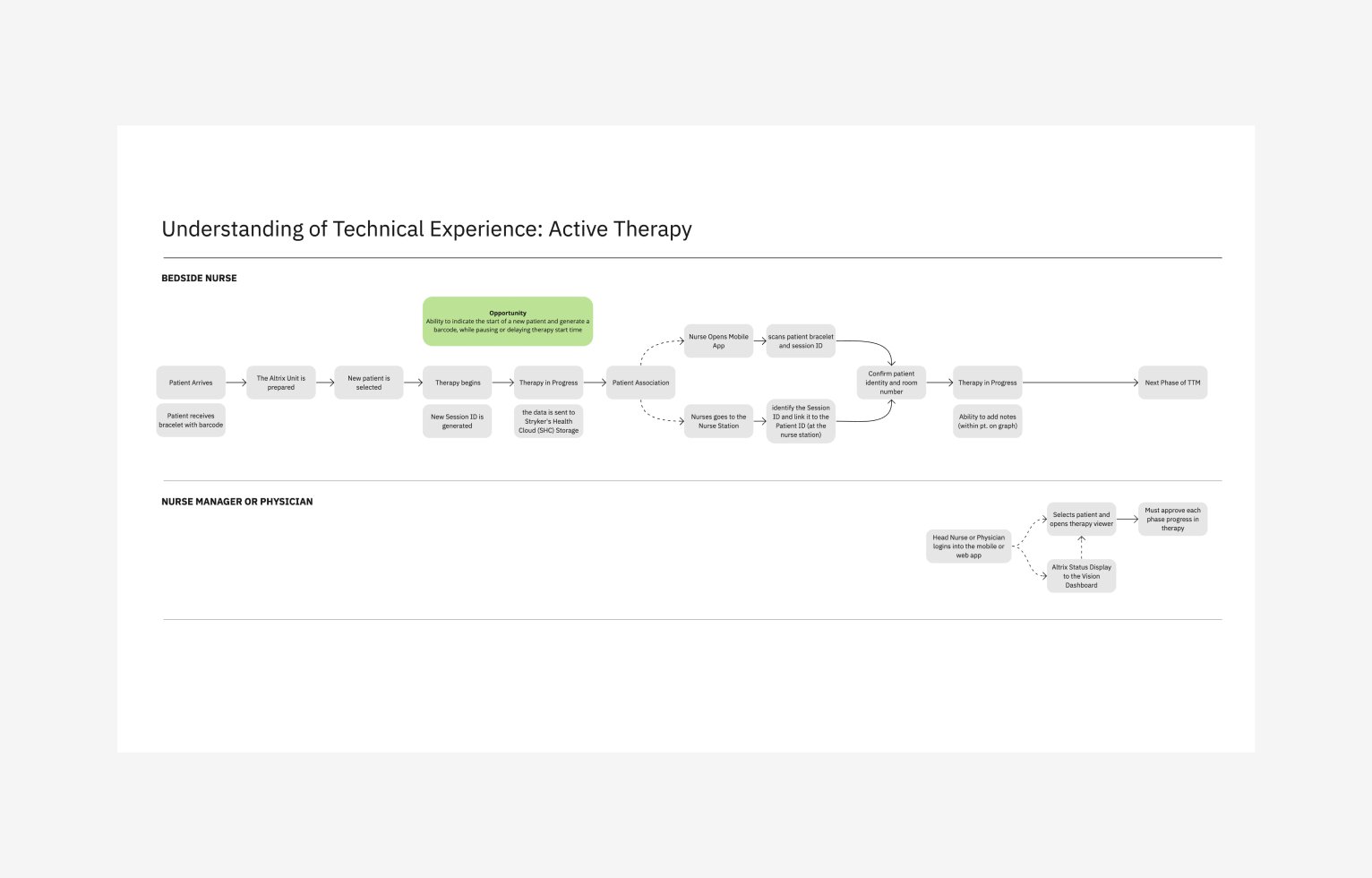
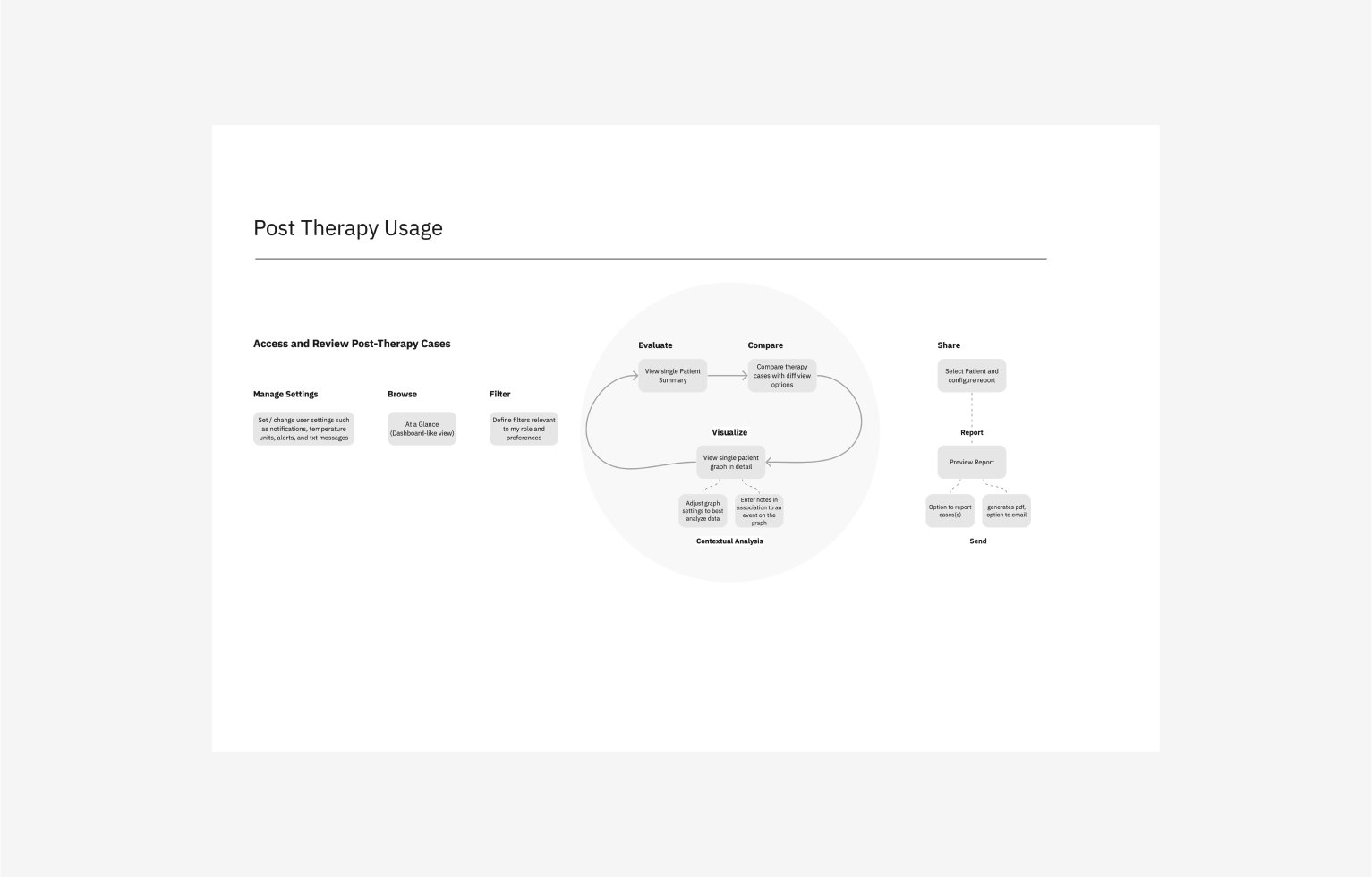
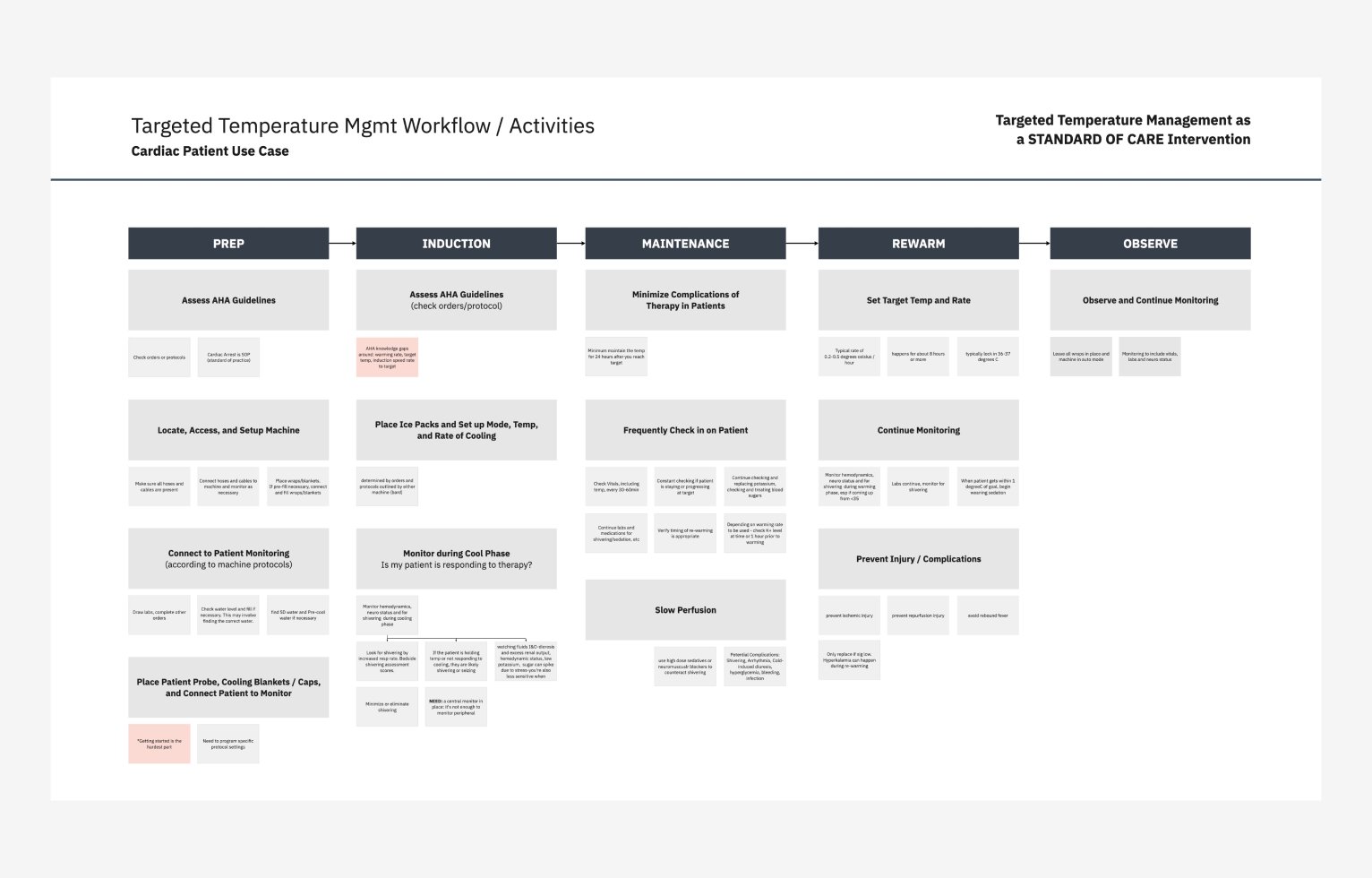
Identifying the technical implications and capabilities for TTM use cases
Service Blueprint
Next, we used our findings to map out the service ecology to identify all the moving parts and their interconnections, dependencies and relationships.
As a result, we aligned on how raw therapy data is processed, sent, and stored to the Stryker Health Cloud and/or copied to the EMR.
Object Oriented UX (OOUX)
Using an object-oriented approach to defining the objects involved in the experience and their relationships and actions offered to end users.
The connection between two objects in a given context. The goal is to gain a bird’s eye view of the strongest relationships. As we defined relationships, we were also defining navigation.
Information Architecture
with Priority Guides
Next, we created priority guides for each portion of the experience to set expectations for functionality and features designed to deliver value.
Feature Mapping
Referencing our priority guides, we developed EPICs and Features and estimated time and effort required.
Designing a mobile-first web app and native mobile app
Initially, we developed a Minimum Viable Product of the web application optimized for mobile devices. Subsequently, we expanded our efforts to create a native mobile application. Utilizing an agile framework, we worked in iterative sprints to clearly outline requirements and regularly showcased new features to the stakeholder group on a weekly basis.
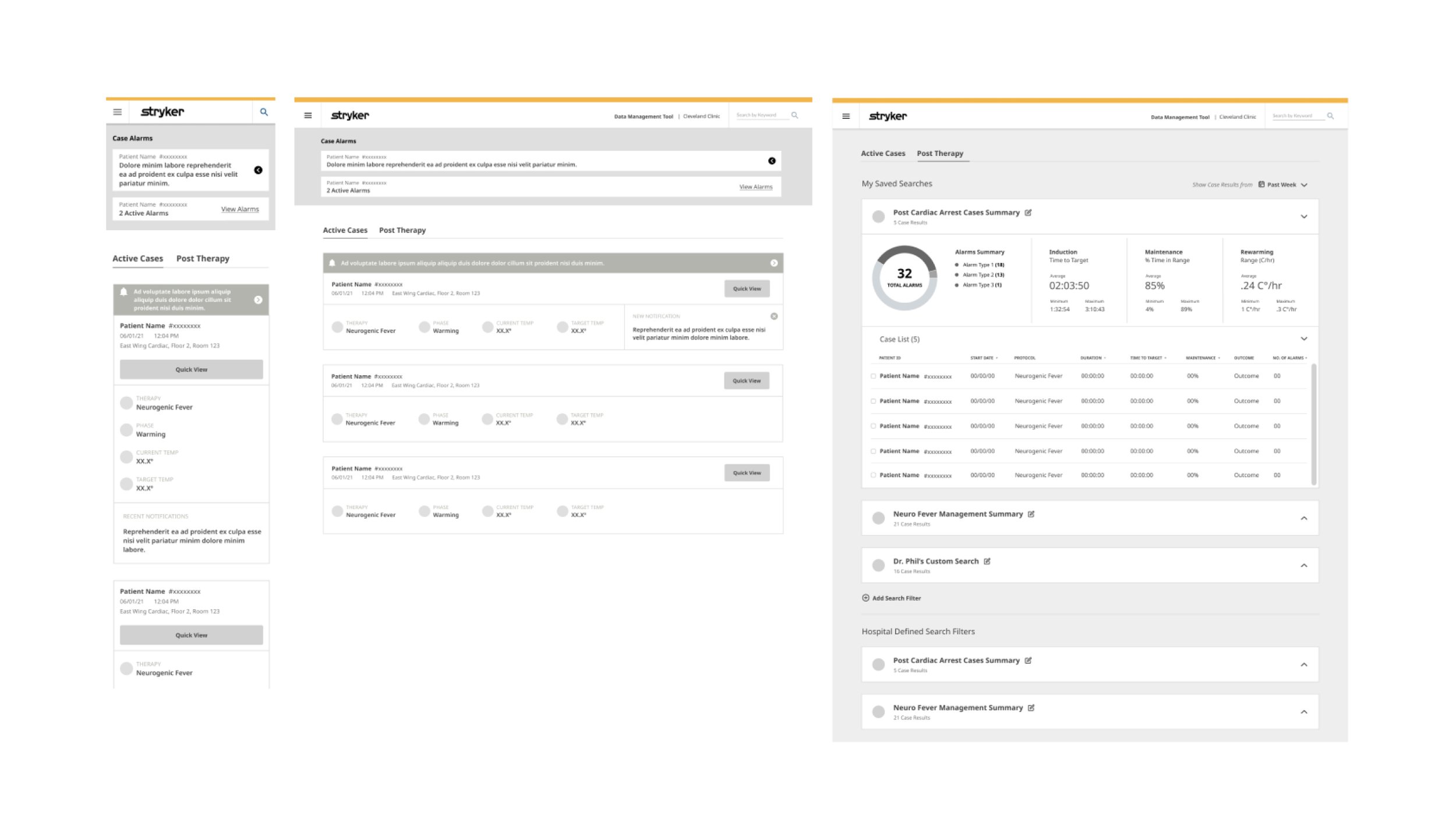
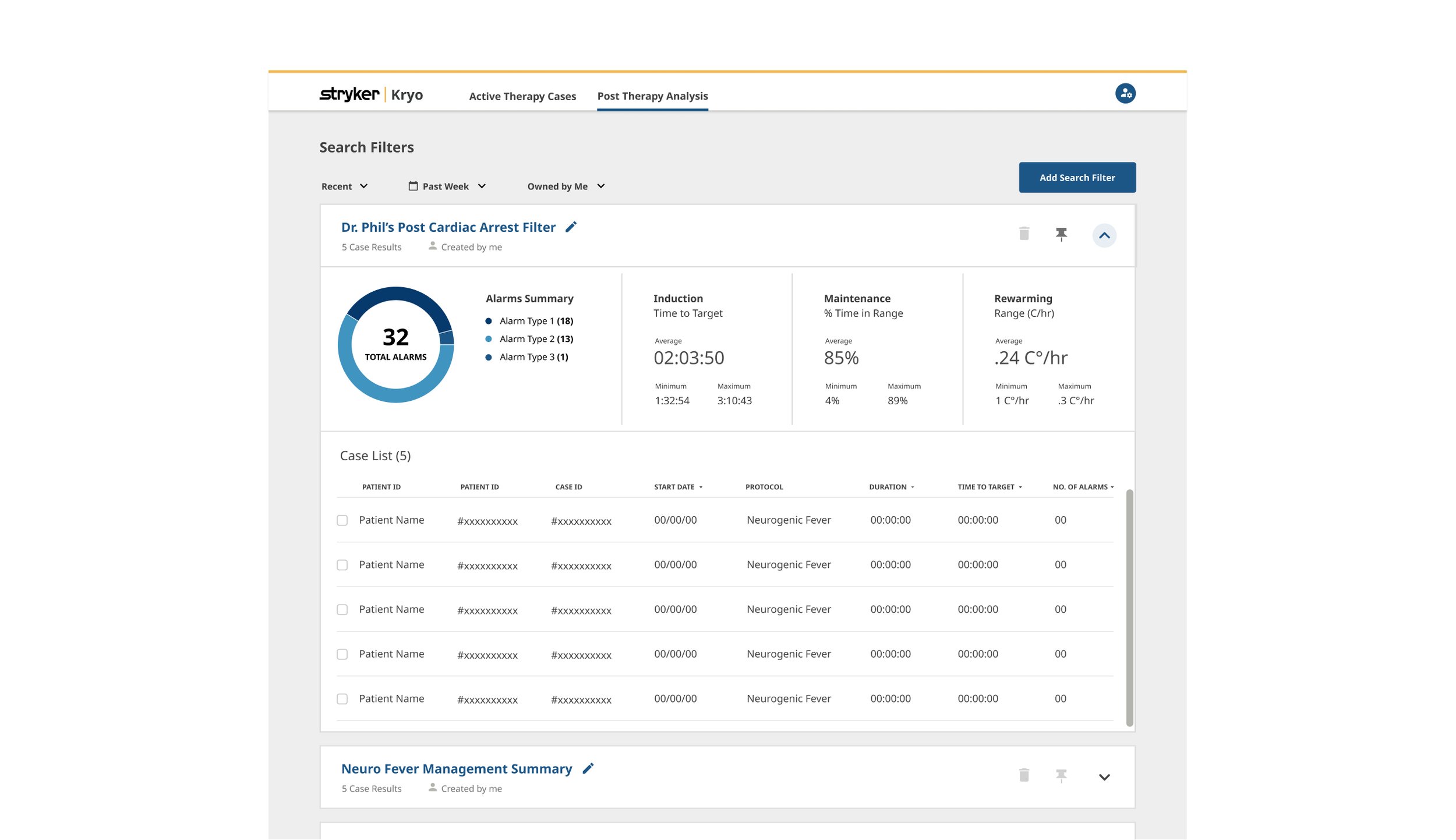
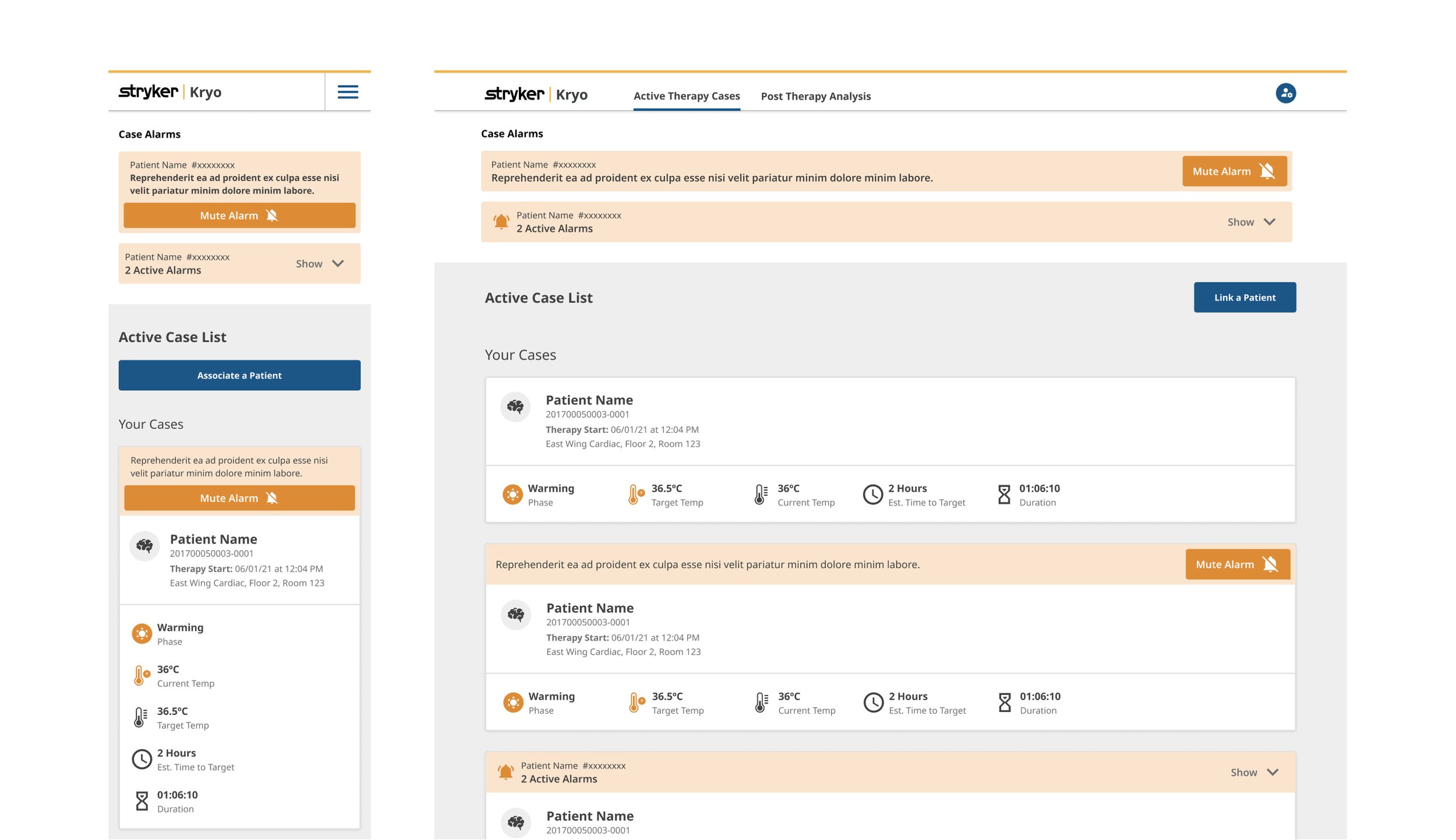
Low and High Fidelity Designs
As part of our course correction in the face of low engagement we split the work across the team and ran a lean process starting with high fidelity wireframes.
We did this to quickly ideate through ideas and force recognition of alignment or gaps in communication.
When we received confirmation that the experience met the necessary business requirements (often limitations) we moved on to creating the UI.
Defining the Value of a Native App
The second phase of the project focused on defining and creating a Native App specific experience designed to deliver a specific set of value features.
This meant understanding what technology could be leveraged to create Native App specific features that would benefit the business or meet user needs.
Limitations and Data Visualization
We had to constantly be aware of current state UIs and potential hospital protocols that may restrict how we designed certain things.
We needed to maintain consistency where possible to limit cognitive overload for end users as well as avoid any potential risks overlapping with critical hospital UI patterns/procedures.
New Reporting Capabilities
With improved charts and graphs, they also wanted to allow clinicians to export their own reports. We explored a few different options to give them a visual overview of what happened during the patients’ TTM cases.
Handing off to Development
When it comes to UX/UI design, a flawless design is only as good as its execution. To ensure a seamless transition from pixel-perfect mockups to a fully functional website or application, a well-executed design to development handoff is crucial, and was a key component to the success of this project.
Working closely with the Stryker development team, we set the tone of a collaborative environment to ensure effective communication and alignment from beginning to end. Through comprehensive documentation, including style guides, component libraries, interactive prototypes, and a well-organized Figma file, we provided the developers with everything they needed to accurately translate designs into code. Our focus on high-quality implementation and adherence to the design system and best practices resulted in a clean, seamless, and well-informed hand-off.
Outcomes
The final designs gave Stryker’s team a streamlined interface to access therapy data in real time, enabling faster, more informed clinical decisions. The improved UI brought clarity to complex information, reducing cognitive load and improving usability across devices.
Key outcomes included:
Increased data accessibility through simplified workflows and modular components
Improved stakeholder alignment by bridging user needs with business goals
A scalable design system that set the foundation for future product iterations
This project demonstrated how thoughtful design can transform healthcare tools into more intuitive, efficient, and outcomes-driven experiences.
What We Learned
Focus in on Key Interactions
Early on, we focused heavily on the big picture—but more time spent examining critical microinteractions (like how users reviewed therapy data) could’ve revealed deeper insights and sharper solutions.
Clarify Requirements Early and Often
Comprehensive documentation and early alignment with stakeholders help surface ambiguities sooner and reduce rework later. Consistent knowledge sharing also became crucial as team members shifted.
Ask More (and Better) Questions
In complex healthcare environments, it's better to over-ask than assume. Clarifying terms, workflows, and priorities with domain experts earlier would have accelerated better decision-making.
Don’t Solve in the Abstract
When designing for edge cases and complex systems, real-world examples are essential. Referencing specific use cases, protocols, and variations upfront would have helped us validate solutions more effectively.
Challenge Assumptions as You Go
Avoiding the “sunk cost fallacy” meant being willing to revisit early ideas, reframe our thinking, and validate often—even if it meant backtracking to move forward more confidently.













